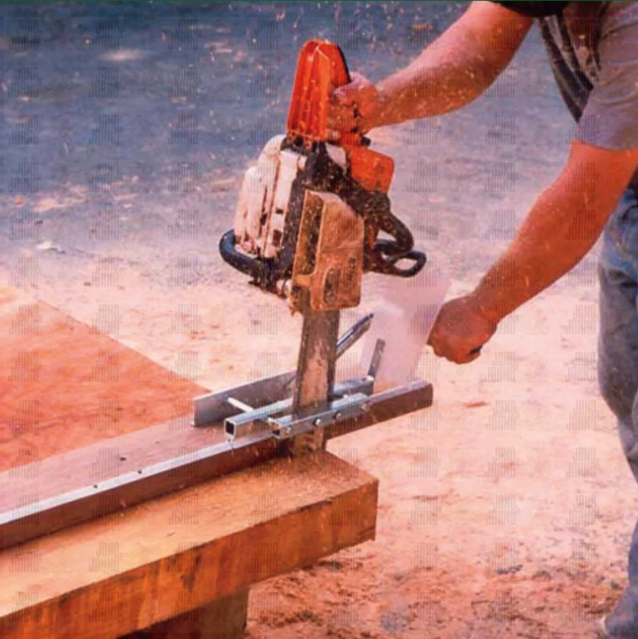What to Do When Your Chainsaw Cuts Crooked
A chainsaw is a powerful and potentially dangerous tool that can cause serious injuries if not properly maintained. Even small issues, like the chainsaw sputtering at an inopportune moment, can lead to mistakes in your cut. A branch might break unexpectedly, or the chainsaw could get stuck inside the tree, creating a hazardous situation. Your chainsaw should cut straight and true. If it starts to veer off course or cuts unevenly, it may be time to check for potential problems. A chainsaw sharpener could help, or you may need to replace the cutting teeth entirely. Here’s what to do if your chainsaw isn’t cutting straight anymore. There are several reasons why a chainsaw might start cutting crooked. It could be due to a dull chain, uneven top plates, or even damaged cutting teeth. Sometimes, improper use or maintenance can also contribute to this issue. The chain is the key component responsible for cutting. If it's not sharpened evenly or becomes dull, the chainsaw won't cut straight. A high-quality chain, such as a Stihl model, can last longer and maintain better performance with regular maintenance. If the chain is too tight, it can create unnecessary pressure and damage the equipment. On the other hand, a chain that's too loose may come off the bar, posing a serious risk to the user. The top plate is the part of the chain that makes contact with the wood. If these are not aligned properly, it can cause the saw to cut unevenly. A worn-out or damaged bar can affect how the chain moves, leading to inaccurate cuts. Always inspect the bar for wear and replace it if needed. Even if you know how to sharpen a chainsaw chain, some teeth may have been damaged during previous use. This can happen when cutting through hard objects like rocks or dirt. An improperly set depth gauge can also cause uneven cuts. The gauge controls how deep the chain cuts into the wood, so it needs to be adjusted regularly as the chain wears down. If your chainsaw isn’t cutting straight, there are steps you can take to fix the issue. Here’s how to sharpen your chainsaw effectively. Start by cleaning the chain thoroughly. Any debris, oil, or grime left on the chain can make it harder to sharpen and increase the risk of injury. Soak the chain in a mixture of water and ammonia to remove any buildup, then rinse and dry before reattaching it to the saw. Next, adjust the chain tension. The chain should be slightly loose on the guide bar but not so loose that it comes off. Use the tensioning screw on the side of the guide bar to make adjustments. Use a chainsaw file to begin sharpening the shortest cutter first. This ensures all teeth are the same length. Once done, mark the tooth so you don’t lose track. Hold the file at the correct angle and file each tooth carefully. Aim for consistency to ensure even cutting performance. After filing one side, move to the opposite side and repeat the process. Make sure the flat tops of the cutters are all the same height after finishing. Finally, check the depth gauges to ensure they are not too long. If they are, file them down slightly to match the cutters. This will help the chainsaw perform more efficiently. A chainsaw that cuts unevenly is a safety hazard. Using a proper chainsaw sharpener can help restore its performance and ensure accurate cuts. Don’t forget to maintain other parts of your equipment for optimal results. Jono & Johno offers a wide range of chainsaw tools, including sharpeners, replacement chains, and safety gear. Visit our website to explore our full selection and reach out with any questions. Rotational molding equipment,rotational molding,rotational molding process Sentis Equipment Co.,Ltd , https://www.spemachine.com
Common Causes of a Chainsaw Cutting Crooked
Uneven Chain Sharpness or Dull Chain
Incorrect Chain Tension
Uneven Top Plates
Worn-Out Chainsaw Bar
Damaged Cutting Teeth
Improper Depth Gauge
How to Sharpen Your Chainsaw Chain Like a Pro
Step 1: Clean the Chain
Step 2: Adjust Chain Tension
Step 3: Sharpen from the Shortest Cutter First
Step 4: File at the Correct Angle
Step 5: Finish the Opposite Side
Step 6: Check the Depth Gauges
Get High-Quality Chainsaw Sharpeners at Jono & Johno
